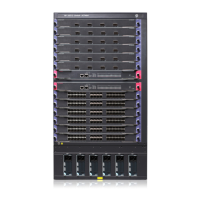144
# Execute the display interface tunnel command on Switch A.
[SwitchA] display interface tunnel
Tunnel1 current state: UP
Line protocol current state: UP
Description: Tunnel1 Interface
The Maximum Transmit Unit is 64000
Internet Address is 9.1.1.1/24 Primary
Encapsulation is TUNNEL, service-loopback-group ID not set
Tunnel source unknown, destination 3.3.3.9
Tunnel protocol/transport CR_LSP
Output queue : (Urgent queuing : Size/Length/Discards) 0/100/0
Output queue : (Protocol queuing : Size/Length/Discards) 0/500/0
Output queue : (FIFO queuing : Size/Length/Discards) 0/75/0
Last 300 seconds input: 0 bytes/sec, 0 packets/sec
Last 300 seconds output: 0 bytes/sec, 0 packets/sec
0 packets input, 0 bytes
0 input error
0 packets output, 0 bytes
0 output error
The output shows that Tunnel 1 is up.
5. Verify the configuration:
# Execute the display mpls te tunnel command on Switch A.
[SwitchA] display mpls te tunnel
LSP-Id Destination In/Out-If Name
1.1.1.9:6 3.3.3.9 -/Vlan1 Tunnel1
1.1.1.9:2054 3.3.3.9 -/Vlan4 Tunnel1
The output shows that two tunnels are present with the outgoing interface being VLAN-interface 1
and VLAN-interface 4. This indicates that a backup CR-LSP was created upon creation of the
primary CR-LSP.
# Execute the display mpls te tunnel path command on Switch A to identify the paths that the two
tunnels traverse:
[SwitchA] display mpls te tunnel path
Tunnel Interface Name : Tunnel1
Lsp ID : 1.1.1.9 :6
Hop Information
Hop 0 10.1.1.1
Hop 1 10.1.1.2
Hop 2 2.2.2.9
Hop 3 20.1.1.1
Hop 4 20.1.1.2
Hop 5 3.3.3.9
Tunnel Interface Name : Tunnel1
Lsp ID : 1.1.1.9 :2054
Hop Information
Hop 0 30.1.1.1
Hop 1 30.1.1.2
Hop 2 4.4.4.9

